
Blockchain: an introduction
In no small part due to the cryptocurriencies boom blockchain has experienced such a rise…
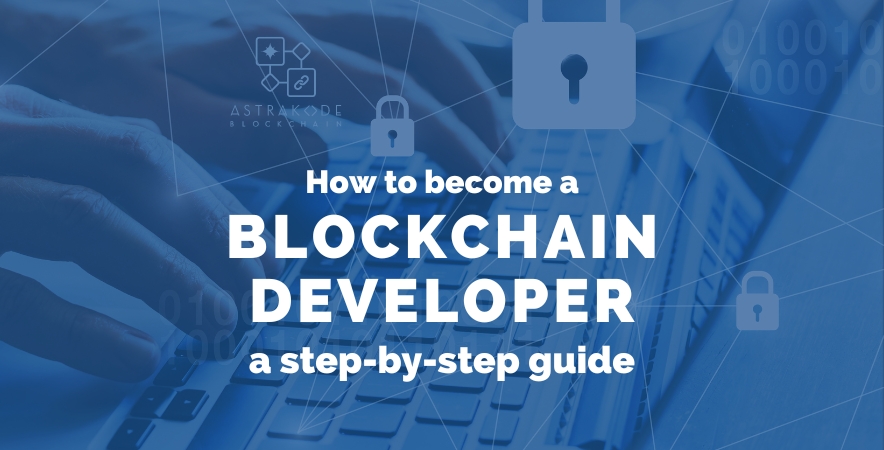
Blockchain technology has taken the world by storm and has become a vital tool in industries ranging from finance to healthcare. As a result, the demand for skilled blockchain developers has skyrocketed in recent years. If you’re interested in pursuing a career in blockchain development, you’re in luck!
In this article, we’ll outline the essential steps you need to take to become a blockchain developer. From understanding the basics of blockchain technology to building decentralized applications, we’ll guide you through the process step-by-step.
Additionally, we’ll introduce you to AstraKode Blockchain (AKB), a low-code blockchain platform that makes blockchain development accessible to anyone, regardless of technical expertise. Read on to discover how to become a blockchain developer and join the revolution!
Generally speaking, it is possible to distinguish between two types of blockchain developers, the core blockchain developer, and the blockchain software developer.
The core developer is responsible for the architecture and security of a blockchain system. Basically, he is responsible for:
The blockchain software developer uses the architecture and protocols designed by the core blockchain developer to build decentralized applications using blockchain technology (dApps). It is a varied qualification and closer to that of the web developer. As such it incorporates a number of separate roles that cannot be covered by a single individual. Its tasks may include:
Having said this, and taking into account the existence of different types of blockchain, it is necessary to understand in which direction to set your specialization. Clearly, this also depends on other factors, related to the technical knowledge you possess and to your own goals: if, for example, you know how to use JavaScript, you have a minimum of experience in front-end development, and you want to learn how to develop smart contracts, you will probably aim to become a blockchain software developer by focusing your interest on Ethereum. On the contrary, if you have a good knowledge of Golang and Node.js and your goal is to become a core blockchain developer, then you will need to specialize in Hyperledger Fabric.
Before delving into the steps of becoming a blockchain developer, it’s important to note that there is some background knowledge you need to have, such as understanding programming languages and the theoretical and structural aspects of the chosen blockchain technology.
Usually, anyone who decides to become a blockchain developer is already a programmer. If you don’t have a background in programming, we strongly recommend that you attend a basic course to deepen your understanding of at least one programming language.
Consequently, if you want to gain a deeper understanding of blockchain development, it’s important to have knowledge of programming languages such as JavaScript, Bash, Golang, and Yaml for Hyperledger Fabric, as well as Solidity, Vyper, and Assembly for public EVM-compatible blockchains.
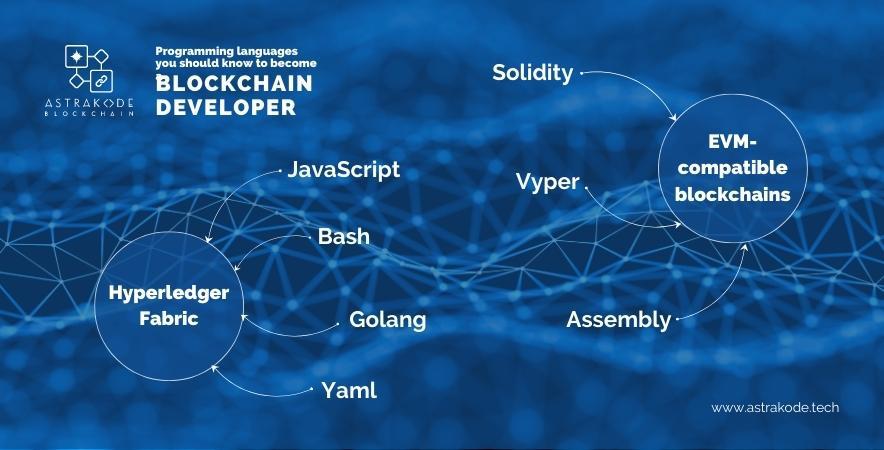
Moreover, to gain a thorough understanding of blockchain development, it’s crucial to study the theoretical and structural aspects of the chosen technology. For instance, in the case of Hyperledger Fabric, you should explore official documentation and focus on fundamental concepts such as channels, organizations, peers, orderers, and Certificate Authorities (CAs). You should also study the typologies and mechanisms for delivering and conserving certifications.
If you want to get started with studying the list of Network Composer components you must know to compose networks, go to our AstraKode WIKI page.
In Ethereum, on the other hand, you should concentrate on smart contract development by studying Solidity, the primary programming language used for this purpose. Although these technical and specific concepts may seem daunting, they are definitely learnable through self-study or by taking courses that offer certificates to verify your newfound skills.
Learn more about Smart Contract IDE components on this WIKI page.
Once you have this knowledge, you can move on to the steps.
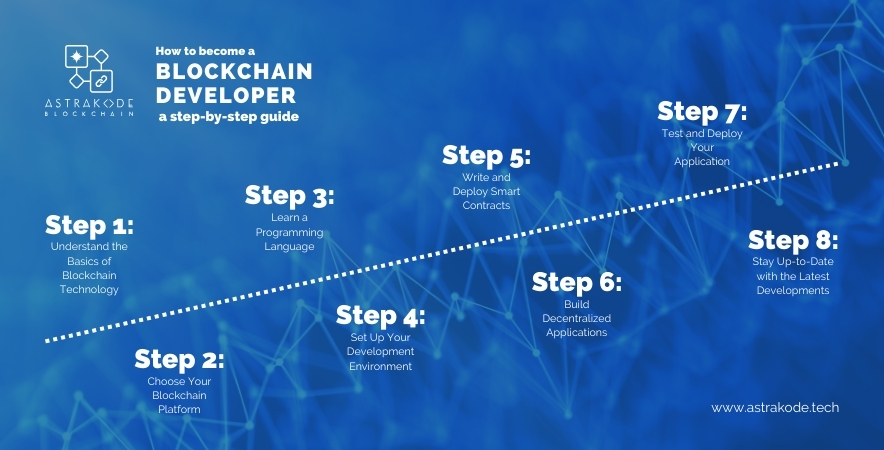
To become a blockchain developer, it’s essential to understand the fundamentals of blockchain technology. But don’t worry, you don’t need to be a tech genius to get started! Begin by reading articles or watching videos that explain blockchain technology in simple terms. This will give you a solid foundation to build upon.
There are several blockchain platforms available, such as Ethereum, Hyperledger, and Corda. Each platform has its own unique strengths and weaknesses, so pick the one that aligns with your goals and interests. For instance, if you’re interested in building decentralized applications, Ethereum is an excellent choice due to its robust smart contract functionality.
Now that you’ve chosen your blockchain platform, it’s time to learn a programming language. The most common languages used in blockchain development are Solidity (for Ethereum) and Golang (for Hyperledger). These languages are relatively easy to learn, especially if you have prior programming experience.
To start developing on a blockchain platform, you need to set up a development environment. This might sound daunting, but don’t worry, it’s not as complicated as it seems. You’ll need to install a blockchain client, such as Geth (Go) for Ethereum or Hyperledger Fabric for Hyperledger. There are plenty of tutorials available online to guide you through the setup process.
Smart contracts are at the core of blockchain technology. They’re self-executing contracts with the terms of the agreement between buyer and seller being directly written into lines of code. Writing and deploying smart contracts is a critical step in blockchain development, as it enables the creation of decentralized applications.
You’ve got the basics down, so now it’s time to start building your first decentralized application! Don’t worry if you feel a bit intimidated – you don’t have to create the next big thing just yet. Start with a simple project, such as a decentralized voting application or a supply chain management system. This will give you valuable hands-on experience with building decentralized apps.
Once you’ve built your application, it’s time to test it thoroughly to ensure it functions as intended. You’ll also need to deploy it to the blockchain network, which can be a bit tricky. But don’t fret – there are plenty of resources available online to help you through this process.
Finally, it’s essential to stay up-to-date with the latest developments in the field of blockchain technology. Attend conferences, read blockchain publications, and network with other blockchain developers to stay informed about the latest trends and best practices.
Blockchain technology is known to be quite intricate, not necessarily due to the technical proficiency required, but more so because of the extensive range of technology components that must be understood and implemented to create a functional blockchain solution, particularly within the Hyperledger Fabric ecosystem. Moreover, it is not easy to find an environment where one can freely practice notions and operations studied only at a theoretical level.
Depending on the level of programming knowledge previously possessed, we believe that a period between 4 and 6 six months is an acceptable timeframe to acquire the basic skills that will provide the opportunity to start a career within a company, as a junior blockchain developer.
AstraKode Blockchain (AKB) has been designed in part to meet this need – to give the possibility to put theoretical knowledge into practice and to speed up the process of developing blockchain solutions.
AstraKode Blockchain (AKB) is a low-code blockchain platform that simplifies the whole process of creating and configuring blockchain networks and smart contracts using an intuitive visual development environment.
Aside from being completely free of charge, this platform offers several other benefits that make it an excellent tool for enhancing your blockchain education. Firstly, the platform has an integrated community that provides support and assistance whenever you need it. Additionally, the platform features an automatic validation system that promptly notifies you of any errors, ensuring that you learn from your mistakes and develop a deeper understanding of the subject matter. Overall, these features make this platform an ideal choice for anyone looking to make a significant contribution to their blockchain education.
In conclusion, the profession of blockchain developer is becoming increasingly important in today’s technology-driven world. With the increasing demand for secure and transparent data transactions, blockchain technology has emerged as a key player in various industries, including finance, healthcare, supply chain management, and more. Blockchain developers play a crucial role in designing, developing, and implementing blockchain-based solutions to meet the unique needs of these industries.
However, developing blockchain-based solutions can be a challenging task that requires specialized skills and expertise. That’s where low-code platforms like AstraKode Blockchain (AKB) can come in handy. By providing a user-friendly interface and pre-built components, AKB allows even those with limited coding experience to build and deploy blockchain-based applications quickly and efficiently.
Moreover, by leveraging low-code platforms like AKB, developers can accelerate the development process and bring their ideas to life more easily and efficiently, leading to even more exciting advancements in the field.

In no small part due to the cryptocurriencies boom blockchain has experienced such a rise…
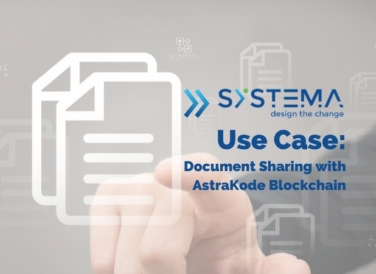
Sharing documents is a common practice in business, but the advent of blockchain technology has…
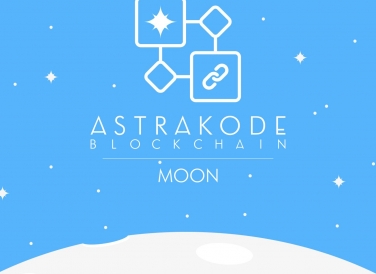
Despite its breakthrough more than 10 years ago, blockchain has not yet become mainstream. There…